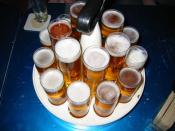Alcohol is a central nervous system depressant. The ethyl alcohol, C2H5OH, contained in alcohol-containing beverages enters the bloodstream as it is absorbed through the stomach and, most efficiently, the intestines. The effects are immediate as the bloodstream becomes dilute with the ethyl alcohol and that blood travels to the brain and spinal cord.
Ethyl alcohol seems to bind to neurons' receptors for gamma-aminobutyric acid (GABA). GABA is an inhibitory neurotransmitter that causes the neuron to stop firing, an important function in the reduction of anxiety. The alcohol appears to increase the effectiveness of GABA at stopping the neurons from firing, resulting in a general sense of calm and well-being for the drinker.
The marked decrease in inhibition causes the drinker to relax, as evidenced by talkativeness and friendliness. Eventually this relaxation pervades and the drinker feels confident, safe and happy. At the same time, ethyl alcohol also depresses the higher cognitive functions such as judgment and fine motor skills.
Alcohol intoxication also causes photosensitivity and dilation of the skin's small blood vessels, increasing skin temperature and giving a reddened appearance. A general feeling of euphoria ensues. It is this feeling that reinforces most non-problem drinkers' behavior.
Continued alcohol ingestion begins to severely impair reason and judgment. An intoxicated person exercises little restraint over his or her speech and actions. He or she experiences confusion and memory lapses. The lack of neurological inhibition can result in emotional extremes ranging from aggression to hilarity.
Symptoms of the next stage of alcohol intoxication include noticeable motor impairment. The person has difficulty with equilibrium and his or her reaction times are increased. He or she will have difficulty standing and locomotion is difficult; he or she will often bump into stationary objects Operation of a motor vehicle becomes extremely dangerous due...


